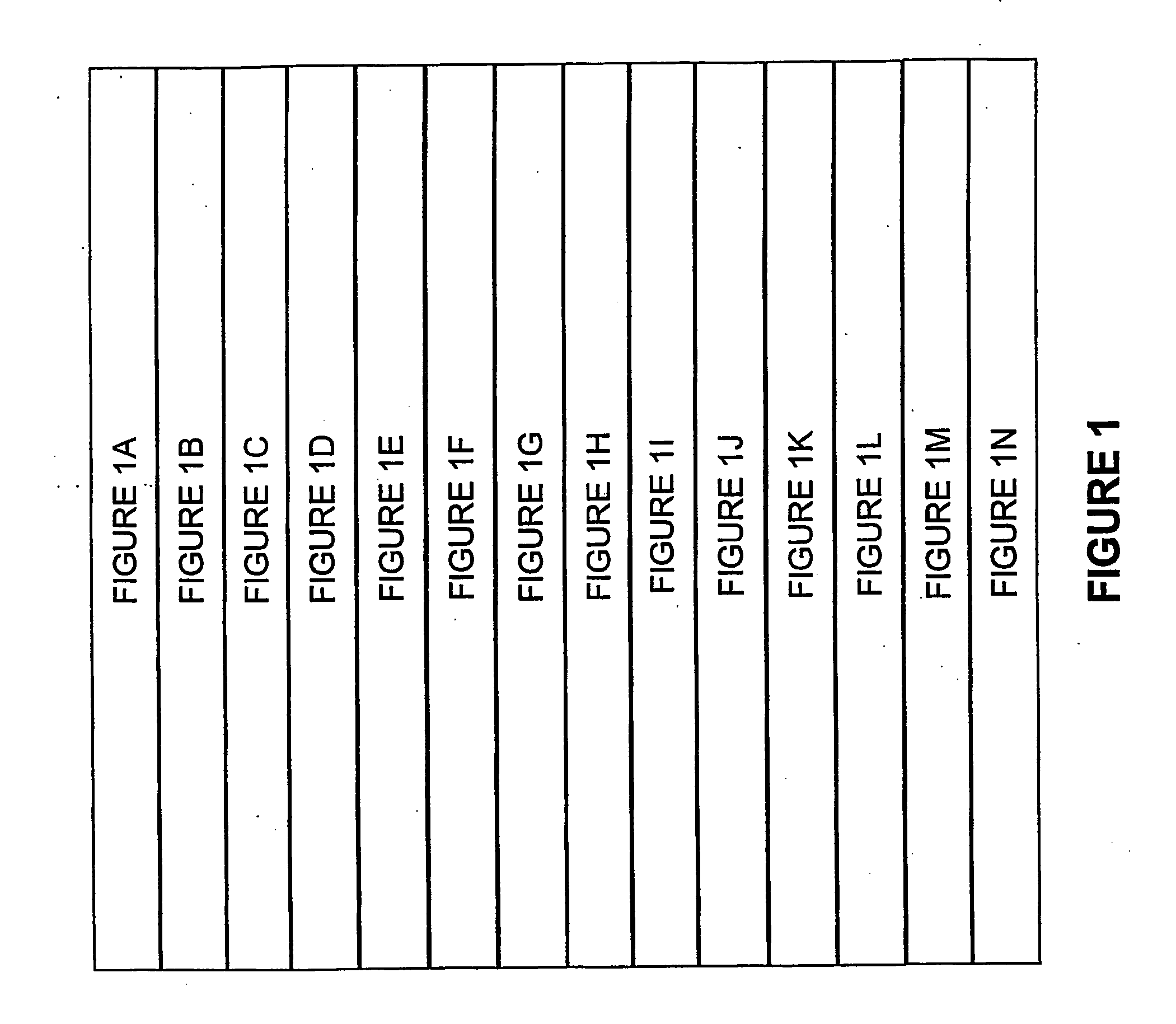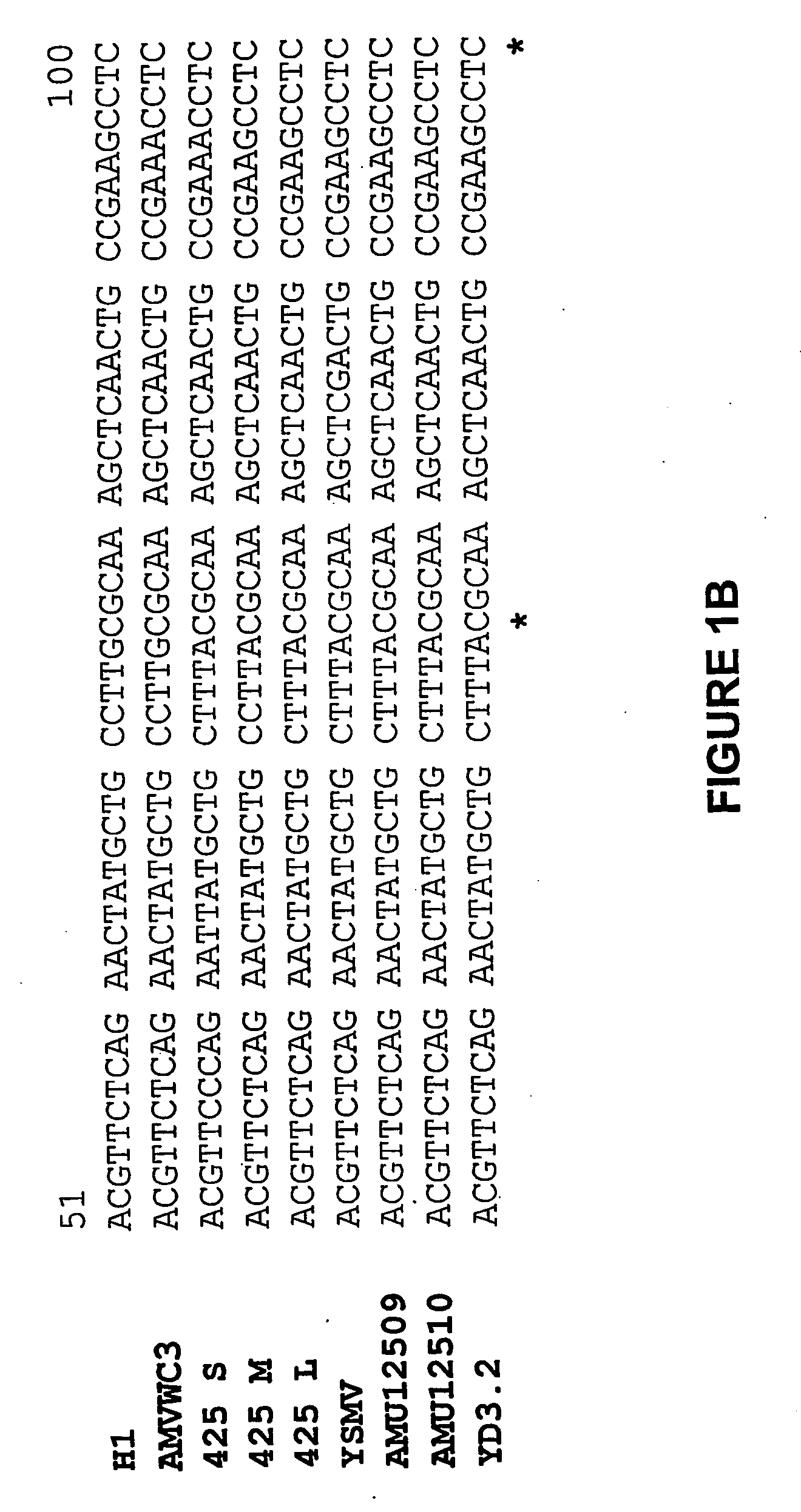Method of enhancing virus-resistance in plants and producing virus-immune plants
a technology of virus resistance and plant, applied in the direction of viruses/bacteriophages, biochemistry apparatus and processes, peptide sources, etc., can solve the problems of reducing farm profitability, subterranean clover herbage and seed yield loss, and major limitations in profitability and further expansion
- Summary
- Abstract
- Description
- Claims
- Application Information
AI Technical Summary
Benefits of technology
Problems solved by technology
Method used
Image
Examples
example 1.2
Nucleotide Sequences of AMV Coat Protein Genes
[0236] Local isolates of AMV (H1, YD3.2 and WC3), obtained from single lesions as described in the preceding Example 1, were used as a virus source for AMV coat protein genes.
[0237] The nucleotide and deduced amino acid sequences of the cloned coat protein gene from three Australian isolates of AMV (H1, YD3.2 and WC3) have been determined using the dideoxy chain termination method (Sanger et al., 1977) to sequence either M13 ssDNA templates (Sambrook et al., 1989) or double-stranded DNA templates prepared by the CTAB method (Del Sal et al., 1989). Sequence analysis was carried out using the University of Wisconsin Genetics Computer Group Sequence Analysis Software Package (Devereaux et al., 1984).
[0238] The nucleotide sequences of the coat protein genes of the Type I isolates H1 and WC3, and the Type II isolate YD3.2 are presented in FIG. 1, aligned to the sequences of the coat protein genes of other Type I isolates (i.e. isolates 425S, ...
example 1.3
Construction of Vectors Comprising the AMV Coat Protein Gene
[0239] All cloning procedures used in the preparation of gene constructs comprising the AMV coat protein genes were as described by Sambrook et al. (1989). The cloning strategy used to create recombinant binary vectors containing the AMV coat protein gene of the H1 isolate driven by the Arabidopsis thaliana SSU promoter and containing either Basta resistance (pTW5) or kanamycin resistance (pTP5) is described below:
[0240] 1. The AMV resistance gene was derived by RT-PCR amplification of the coat protein ORF from partially-purified RNA of AMV strain H1 (a Subgroup I AMV from South Australia, isolated by the late Dr Richard Francki of the Waite Agricultural Research Institute, University of Adelaide, South Australia, Australia), using primers deduced from published sequences of the AMV genome, each of which incorporates a BglII site (bold, underlined text), as follows:
[0241] Forward primer: 5'-CCAGATCTTCCATCATGAGTTC-3' SEQ ID ...
example 1.4
Isolation and Characterisation of Australian Isolates of CYVV
[0251] Australian isolates of CYN (summarised in Table 2) from white clover and other plants were obtained from tissues showing virus-like symptoms collected from various sites. The virus was identified by bioassay on Chenopodium quinoa which produced typical necrotic local lesions followed by local and systemic leaf necrosis and death. Single-lesion isolates of CYVV were confirmed by host range analysis, electron microscopy and ELISA, and were propagated and maintained in broadbeans and white clover, cv. Waverley. Isolates of CYVV that are infectious on all three representative non-transgenic irrigation white clover plants were used for challenging transgenic plants, and the infectivity data are presented in Table 3.
PUM
| Property | Measurement | Unit |
|---|---|---|
| density | aaaaa | aaaaa |
| fresh weight | aaaaa | aaaaa |
| pH | aaaaa | aaaaa |
Abstract
Description
Claims
Application Information
 Login to View More
Login to View More - R&D
- Intellectual Property
- Life Sciences
- Materials
- Tech Scout
- Unparalleled Data Quality
- Higher Quality Content
- 60% Fewer Hallucinations
Browse by: Latest US Patents, China's latest patents, Technical Efficacy Thesaurus, Application Domain, Technology Topic, Popular Technical Reports.
© 2025 PatSnap. All rights reserved.Legal|Privacy policy|Modern Slavery Act Transparency Statement|Sitemap|About US| Contact US: help@patsnap.com



